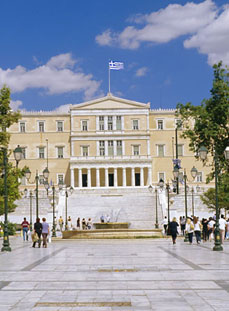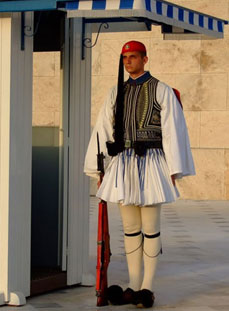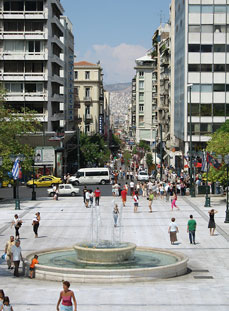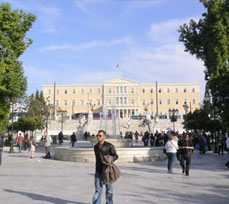



Athens Syntagma Square
The gently sloping Syntagma Square (Plareia Syntagmatos = Constitution Square) id located in the heart of the modern Athens. It is bounded by Vasilissis Amalias ave. on the east. Vasileos Georghiou A' str. on the north, Stadiou str. on the west and Othonos str. on the south. After the large- scale havoc inflicted on the Square for the general construction of the Attiki Metro and the major station here, a new plan has been drawn up to return this central focus of Athenian and Greek life back to the people. This was accomplished by reshaping and upgrading it without sacrificing its historical character, restoring the trees and plants, as well as redirecting and restricting the traffic flow around it. Ideally, the uncluttered style of the Neoclassical tradition will be merged with the contemporary needs and Metro.
An ancient inscribed boundary stone found in the Square suggests the existence in its upper part of a garden associated with a Sanctuary of the Muses, The Mouseion. This we are told was in the private garden of the philosopher named Theophrastos (actually Tyrtamos from Eressos on Lesbos Island) who succeeded Aristotle after his death in 322 BC as "director" of the "Peripatetic School" at the Gymnasion in the Lykeion, the shrine of Apollo Lykeios ("wolf - god"). Theophrastos (371 - 287 BC) was one of a group of philosophers called the Peripatetics who discussed their ideas amongst themselves while walking or strolling about on a pathway (peripatos) in the gymnasion. In 320 BC he was given the Garden of the Muses by the Athenian Demetrios of Phaleron (who served as the "governor", or rather tyrant, of the city between 318 and 307 BC, for the usurper of the Macedonian throne, Kassander).
The road forming the southern side of the square, Othonos str. (and then on to Apollonos sttr. to the southwest), follows approximately the line of an ancient road which led out of the city from Gate VIII ("Diochares") to the Mesogeia in the northeastern part of Attica. In the general area where Othonos str. ends in Vasilissis Amalias ave., there was the simple Boubounistra Gate (named after the nearby low hill Lophos Boubounistras) of the Serpentzes wall built by Hadji Ali Haseki in 1778 during the sultanate of Abdul Hamit I. This poorly built defensive system encircled a large area of northern and eastern Athens. In places it was built on top of the remains of the Themistoclean wall. Spolia from various ancient monuments and buildings were used extensively in its masonry. An example of this destructive practice was that an inscribed marble architrave taken from the lonic facade of Hadrian's "reservoir" on the southeastern slopes of Lykavittos Hill was used as the external lintel block for the gate. Other ancient marble blocks were used for the jambs. This "reservoir" was part of an aqueduct for the city, the building of which was started by Hadrian in AD 125 and finished by Antoninus Pius in AD 140. The traveler Cyriacus of Ancona recorded this inscription still in its original position, when he visited Athens in 1436/7. The gate, built as part of the Serpentzes wall in 1778, received its name from the Turkish fountain (cesme), which was called the "Boubounistra Fountain" (after the nearby hill) situated just outside the gate. The gate is known to have stood until at least 1809. The inscribed architrave was for a long time set up in the National Garden.
Syntagma Square was laid out in about 1835/36 as part of the expanded street plane of the new capital city Athens. Leo von Klenze (1784 - 1864), the architect of the Bavarian king Ludwig I (the father of Greece's first king Othon), executed this plan based on a modification of the radical ideas (i.e. demolish the old unplanned Ottoman/Byzantine town and built a planned modern European City) of Stamatios Kleanthis (1802 - 1862) and Edouard Schaubert (1804 - 1860) that they drafted in 1831/2. The designer of the royal residence, Friedrich von Gaertner a rectangular open space here rather than the original circular one. The resulting square formed one of the focal points of the new city, lying beyond the limits of the late Roman town on the southern side of the Acropolis. From the beginning the square was a place frequented by Athenians because of its planted gardens and vast the out - of - doors coffeehouses/cafes (kafeneia) situated in and around it. These features and the palace made it one of the places to build hotels in the late 19th - and early 20th centuries. Executed I Neoclassical style, the Grand Hotel d'Angleterre, later in "New England Hotel" and "Foreigners'/Guests' Hotel" were demolished as the Square was "modernized" after World War II.
Syntagma (meaning : Constitution) Square gained its name when King Othon, on March 1844, swore his oath supporting, in theory, a new constitution with a bicameral or two - tier parliamentary form of government from the balcony of his palace to the people gathered below. He was forced to do this after a long festering popular revolt which culminated when on September 3, 1843, the people supporting General Demetrios Kallergis went to the palace demanding constitutional rights for the citizens of the new kingdom and the expultion of Othon's hated Bavarian advisers. This bloodless revolution was the brought about by the former grievances and, more importantly, by the fact that the king had been ruling as an absolute monarch since he returned to Athens in 1839 with his Protestant bride, Amalia.
